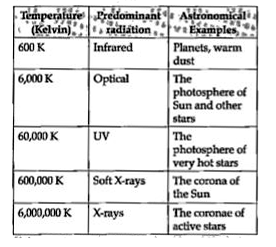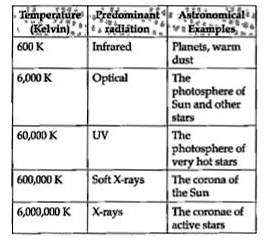For a given base line, which will show a grater parallax - a distant star or a nearby star?
Step by step video & image solution for For a given base line, which will show a grater parallax - a distant star or a nearby star? by Physics experts to help you in doubts & scoring excellent marks in Class 11 exams.
Updated on:21/07/2023Topper's Solved these Questions
Similar Questions
The spectral line for a given element in the light received from a distant star is shifted towards longer wavelength side by 0.032%. Deduce the velocity of star in the line of sight.
View SolutionThe spectral line for a given element in the light received from a distant star is shifted towards longer wavelength side by 0.025%. Calculate the velocity of star in the line of sight.
View Solution
Knowledge Check
The spectral line for a given element , received from a distant star is shifted towards the longer wavelength by 0.028%. What is the velocity of the star ?
Aa) 5.6×104m/sBb)8.4×104m/sCc)4.2×104m/sDd)9.8×104m/sWhich is the closest star to earth?
ASiriusBSunCRigelDDenebWhich is the nearest star to Earth?
APole starBSunCDog starDSirius
The spectral line for a given element in light received from a distant star is shifted towards longer wavelength by 0.024%. Deduce the velocity of star in the line of sight.
View SolutionThe principle of 'parallax' in Art. 1(c ).4. is used in the determination of distacne of very distant stars. The baseline AB in the line joining the Earth's two locations six months apart in its orbit around the sun. That is, the baseline is about the diameter of the Earth 's orbit ≈3×1011m. However, even the nearest stars are so distnat thet with such a long baseline, they show parallax only of the order of 1''(second) of arc or so . A parsec is a convenient unit of length on the astronomical scale. It is the distance of an objhect that will shown a parallax of 1'' (second) of arc fome oppsoite ends of a beasline equal to the distance from the Earth to the sun. How much is a parsec in terms of metres ?
View SolutionRead the following text and answer the following questions on the basis of the same:
Spectrum Analysis and Astronomy
Each element in the periodic table can appear in gaseous form and produce its own spectrum unique to that element. Hydrogen will not look like Helium, which wil not look like carbon which will not look like iron....and soon. Astrophysists can identify what kinds of materials are present in stars from the analysis of star's spectra. This type of study is called astronomical spectroscopy. The science of spectroscopy is quite sophisticated. From spectrum lines analysis astrophysists can determine not only the element, but the temperature and density of that element in the star. The spectral line also can tell us about any magnetic field of the star. The width of the line can tell us how fast the material is moving. We can learn about winds in stars from this. The shifting of spectral liens shift back and forth indicates that the star may be orbiting another star. The following table shows a rough guide for the relationship between the temperature of a star and the electromagnetic spectrum.

If the spectrum of a star is red or blue shifted, then it can be used to infer its velocity along the line of sight. Edwin Hubble observed that more distant galaxies tended to have more red shifted spectra. This establishes the theory of expansion of the universe.
From the spectrum analysis the following information of a star can be obtained
View SolutionRead the following text and answer the following questions on the basis of the same:
Spectrum Analysis and Astronomy
Each element in the periodic table can appear in gaseous form and produce its own spectrum unique to that element. Hydrogen will not look like Helium, which will not look like carbon which will not look like iron....and soon. Astrophysists can identify what kinds of materials are present in stars from the analysis of star's spectra. This type of study is called astronomical spectroscopy. The science of spectroscopy is quite sophisticated. From spectrum lines analysis astrophysists can determine not only the element, but the temperature and density of that element in the star. The spectral line also can tell us about any magnetic field of the star. The width of the line can tell us how fast the material is moving. We can learn about winds in stars from this. The shifting of spectral liens shift back and forth indicates that the star may be orbiting another star. The following table shows a rough guide for the relationship between the temperature of a star and the electromagnetic spectrum.

If the spectrum of a star is red or blue shifted, then it can be used to infer its velocity along the line of sight. Edwin Hubble observed that more distant galaxies tended to have more red shifted spectra. This establishes the theory of expansion of the universe.
Which nature of spectrum establishes the theory of the expanding universe?
View SolutionRead the following text and answer the following questions on the basis of the same:
Spectrum Analysis and Astronomy
Each element in the periodic table can appear in gaseous form and produce its own spectrum unique to that element. Hydrogen will not look like Helium, which will not look like carbon which will not look like iron....and soon. Astrophysists can identify what kinds of materials are present in stars from the analysis of star's spectra. This type of study is called astronomical spectroscopy. The science of spectroscopy is quite sophisticated. From spectrum lines analysis astrophysists can determine not only the element, but the temperature and density of that element in the star. The spectral line also can tell us about any magnetic field of the star. The width of the line can tell us how fast the material is moving. We can learn about winds in stars from this. The shifting of spectral liens shift back and forth indicates that the star may be orbiting another star. The following table shows a rough guide for the relationship between the temperature of a star and the electromagnetic spectrum.

If the spectrum of a star is red or blue shifted, then it can be used to infer its velocity along the line of sight. Edwin Hubble observed that more distant galaxies tended to have more red shifted spectra. This establishes the theory of expansion of the universe.
What is astronomical spectroscopy?
View Solution
